Nestled deep in the mountainous northwest of Thailand, Mae Hong Son feels like one of the country’s last frontiers. Surrounded by hills and bordering Myanmar, it’s a province shaped by remoteness and rich traditions. It’s gentle pace of life that makes it feel worlds away from Bangkok or even Chiang Mai.
We visited Mae Hong Son in November 2024 and were blown away by its calm, laid-back atmosphere, delicious food, and the incredible views at every turn. After spending a few weeks in crowded Chiang Mai, we were seeking an escape from the chaos. We were eager to explore northern Thailand’s lesser-known attractions. If you dare to go further than Pai, you will find a quiet and untouched side of Thailand. Ideal for anyone looking to get to know Thailand beyond tourist hotspots.
In this guide, we’ll go over all the things you need to know when planning a trip to Mae Hong Son province. We’ll walk you through how to get there, what to see, what to eat, and why Mae Hong Son is worth the journey.
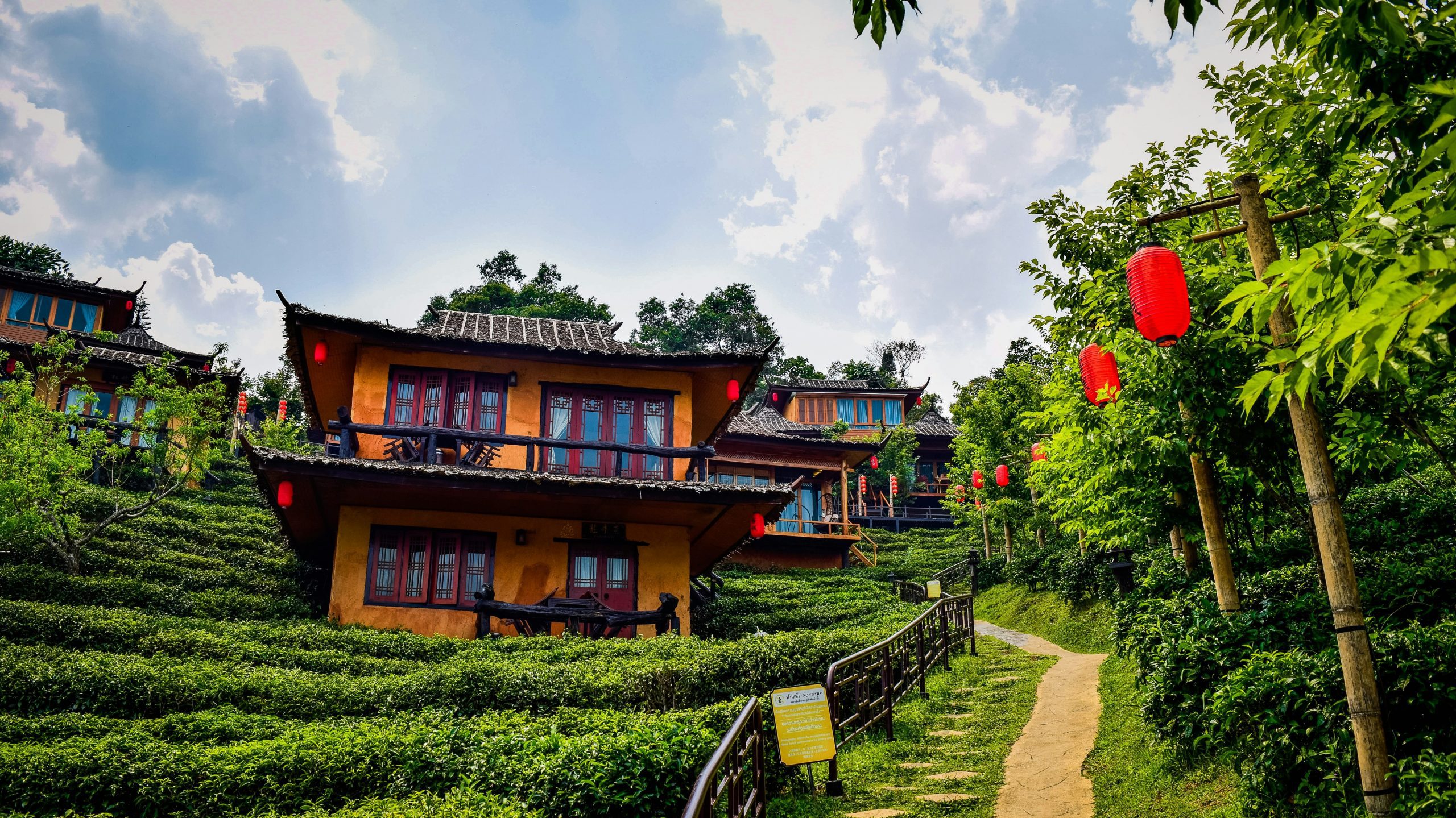
How to Get to Mae Hong Son
Because the province is tucked away in Thailand’s most mountainous region, there’s no direct train line and limited bus access compared to other areas. But that remoteness is exactly what gives Mae Hong Son its charm. Below, we’ll walk you through the main ways to reach Mae Hong Son.
Flying into the Mountains
The quickest and most convenient way to get to Mae Hong Son City is by air. Bangkok Airways flies to Mae Hong Son from Bangkok and Lampang, a province neighbouring Chiang Mai. There are a few flights a week with prices starting at 1,600 THB. Domestic flights operate between Chiang Mai and Mae Hong Son daily, taking just 40–50 minutes. The airport is small and centrally located, just minutes from the town’s main attractions. So you’ll be checked in and out in no time. However, keep in mind that flights can be limited and sometimes get cancelled due to fog in the cooler months, especially between December and February. If you’re short on time or travelling with kids, this is by far the easiest option.
Taking the Van: Twists, Turns & Motion Sickness
Most people travel by van to Pai or Mae Hong Son. Several vans depart each day from Chiang Mai Arcade Bus Station. The operator of the vans is Prempracha Transport. The journey takes around 4 hours to Pai and around 6 hours to Mae Hong Son City. The van will pass through Pai first before heading further to the province’s capital.
The first part of the journey to Pai is the most scenic but also the worst in terms of motion sickness. You’ll pass through some of the most stunning mountain scenery in northern Thailand. The route includes dense forests, highland villages, and more curves than you can count. The road reportedly has 1,864 bends. When I took the van to Pai for the first time a few years ago, I had heard about people getting sick on the journey, but I was sure it couldn’t be that bad. However, I was promptly proven wrong when four people in the van threw up on the bendy roads. So our tip is to definitely buy motion sickness tablets. They make the journey significantly more enjoyable.
Drive along the Mae Hong Son Loop
For those who want to be as flexible as possible, driving your own car or motorbike around the Mae Hong Son Loop is the best option. The full loop starts and ends in Chiang Mai, covering around 600 km. It passes through Pai, Mae Hong Son City, Mae Sariang, and numerous smaller towns along the way. The roads are generally in good condition, though expect sharp curves, steep inclines, and the occasional pothole.
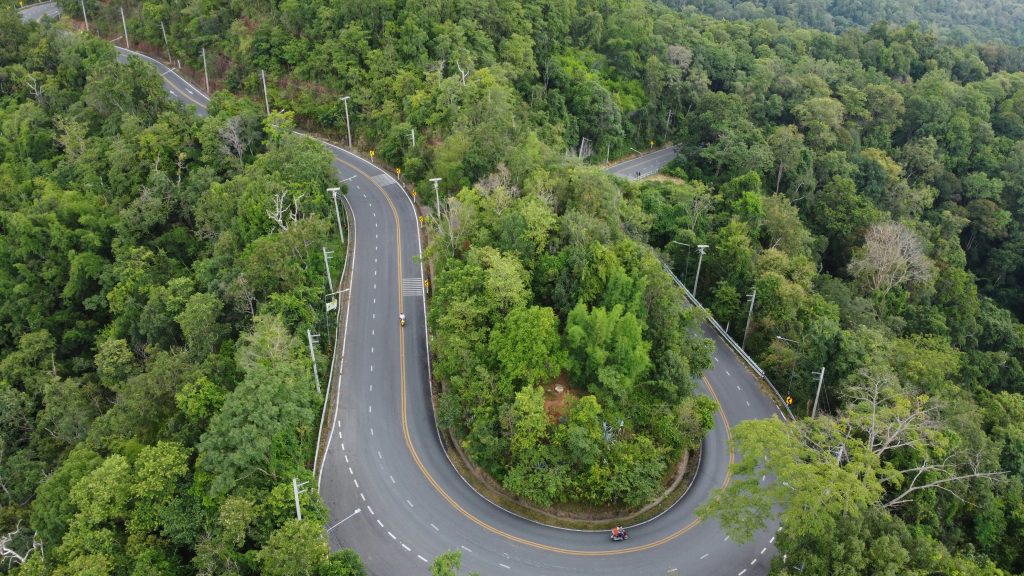
It’s not a good route for the inexperienced motorcyclist. While a motorbike gives you the freedom to stop anywhere – waterfalls, caves, bamboo bridges – it can be a deathtrap for those without enough experience.
Popular Places to Visit in Mae Hong Son Province
The mist-shrouded mountains, peaceful valleys, and far-flung towns and villages, each with its own character, compose Mae Hong Son Province. Slow travel, hiking in the wild, or immersion in local cultures – either way, you’re spoiled for choice here. Far less visited than other parts of Thailand, this region remains unpretentious. You won’t see huge tour groups or skyscrapers of hotels. You’ll instead find yourself discovering sleepy lakeshore temples, steaming hot Shan noodles, and forest paths almost entirely unscathed. Below are some of our most abiding memories – from the laid-back village of Pai to the tea-filled mountain air of Ban Rak Thai.
Mae Hong Son City
Tucked into a lush mountain valley just 20 kilometres from the Myanmar border, Mae Hong Son City is the peaceful heart of the province. It’s a compact and walkable town with a charming blend of Burmese and Lanna architecture. It truly reflects the cultural mix of the area.
Wat Phra That Doi Kong Mu
Perched high above Mae Hong Son town on Doi Kong Mu hill, this iconic white temple is one of the most striking landmarks in the province. Built in the late 1800s by the Shan people, Wat Phra That Doi Kong Mu combines Burmese and Lanna architectural styles, with its two chedis glowing brightly in the afternoon sun. The climb up the steep hill is well worth the effort for the sweeping panoramic views over the town. We arrived just before sunset and watched the sky shift from gold to lavender. The atmosphere was serene and almost surreal, especially with the cool mountain breeze and the faint scent of incense in the air. There’s a small café at the top, too, where you can sip Thai iced tea while taking in the view.
Walking Street
A lot smaller than Chiang Mai’s walking street, but still full of charm, is Mae Hong Son’s walking street. This night market sets up along the road near the lake and Wat Chong Kham every evening. Compared to the more chaotic and crowded markets in Chiang Mai or Pai, this one feels refreshingly local and laid-back. It’s the perfect place to try northern Thai street food and other regional specialities. We actually ended up getting Khao Soi every evening we spent in Mae Hong Son.
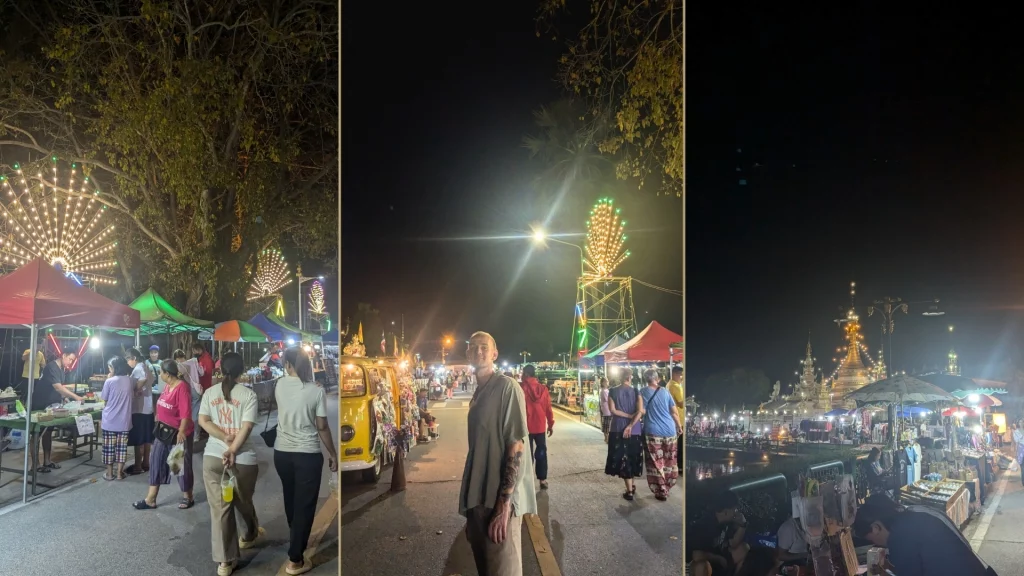
Besides local dishes, you’ll also find handmade crafts, local textiles, soaps, and some quirky souvenirs. The atmosphere is super friendly, and many of the vendors are happy to chat or offer samples. It’s not a sprawling market; you can take your time, try a bit of everything, and still be done in under an hour. A perfect way to spend a calm, cool evening after a day of exploring.
Nong Chong Kham Lake
Right in the centre of Mae Hong Son town, this tranquil little lake is the heartbeat of the community. Bordered by towering palm trees, neat walking paths, and wooden benches, Nong Chong Kham Lake is where locals come to exercise, relax, and socialise. Most people come especially in the cool early morning or just before dusk. The lake itself is perfectly still, often reflecting the white chedi of Wat Chong Kham like a mirror. In the evening, the surrounding area transforms into a small night market, with vendors setting up stalls along the eastern edge. We loved strolling here just after sunset and enjoying Khao Soi sitting by the water. It’s not a flashy attraction, but very relaxing. It’s the kind of place that makes Mae Hong Son feel like a peaceful village rather than a provincial capital.
Wat Chong Kham
Located right beside Nong Chong Kham Lake, Wat Chong Kham is a beautiful, Burmese-style temple and one of the oldest religious sites in town. Its woodwork and golden chedis are particularly eye-catching in the early morning light when the whole structure seems to glow. Shan artisans built the temple in the 19th century. To this day, it continues to serve as a focal point for the local community. Inside, you’ll find delicate carvings, aged murals, and a calm, meditative atmosphere. While it’s not as expansive as Wat Phra That Doi Kong Mu, it offers a glimpse into Mae Hong Son’s spirituality. It’s also beautifully lit at night, with its reflection shimmering on the lake’s surface. Unsurprisingly, it is one of the most photogenic spots in town after dark.
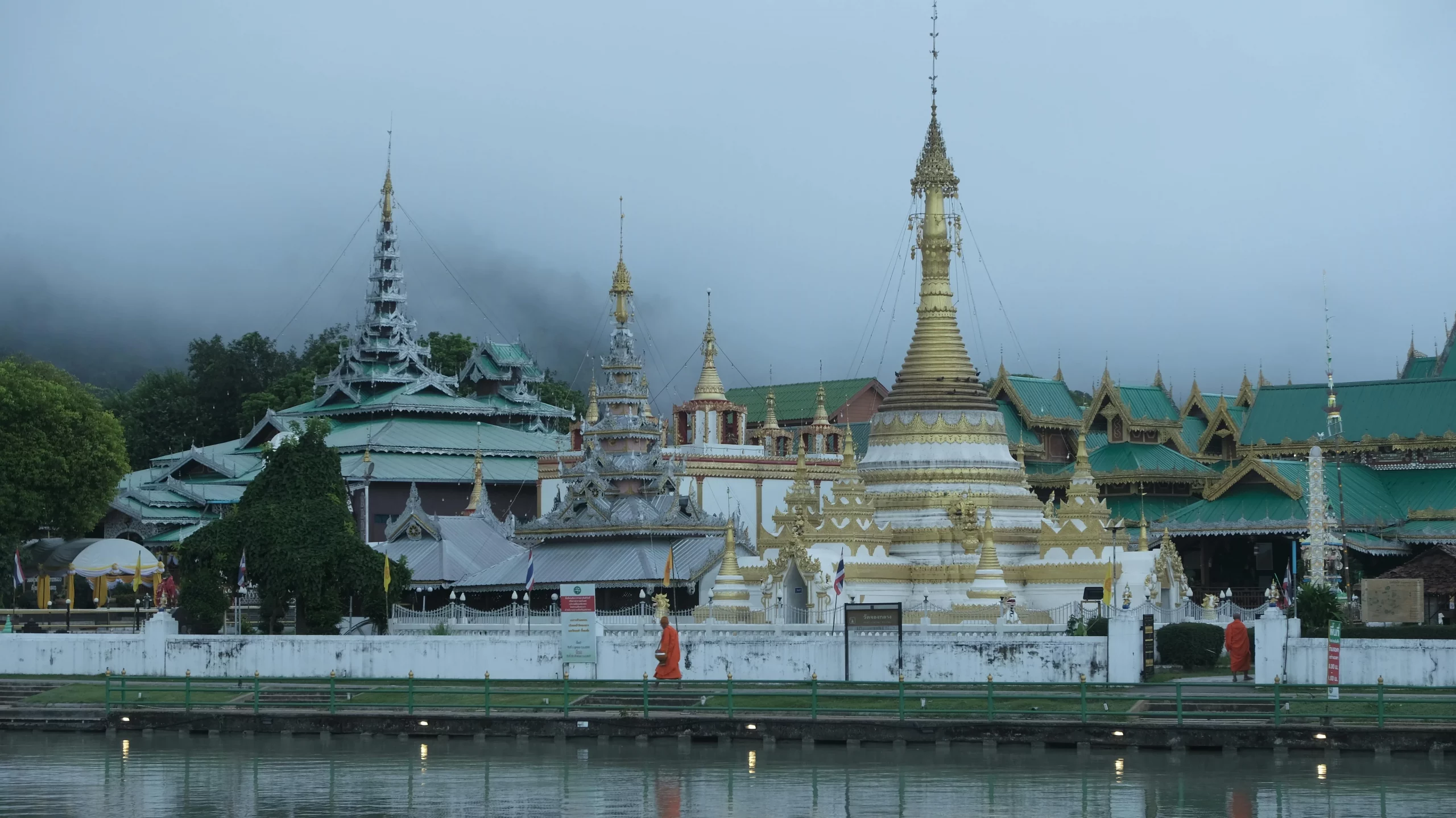
Su Tong Pae Bridge
Su Tong Pae is the longest bamboo bridge in Thailand and one of the most peaceful and photogenic spots we visited in Mae Hong Son. It is just a short drive away from town. Instead of taking a car or scooter, we decided to cycle. We rented two mountain bikes from a bike rental on Khunlumprapas Rd. We paid around 300 THB to rent the bikes for the day. On the way to the bridge, we took some smaller roads as we assumed this would be the nicer route. While this route might have been more scenic, it was significantly steeper, which is why it took us a good 90 minutes to cycle to the bridge. On the way back, we cycled along the main road. This route took us about 60 minutes, including a quick stop at 7-11 for some refreshments.
The 500-metre-long bamboo bridge stretches over green rice fields, leading from the village of Kung Mai Sak to a forest temple tucked away in the hills. Built by local monks and villagers, the name “Su Tong Pae” means “successful prayer” in the Shan language. It was an interesting place to visit – very quiet, calm and not too crowded.
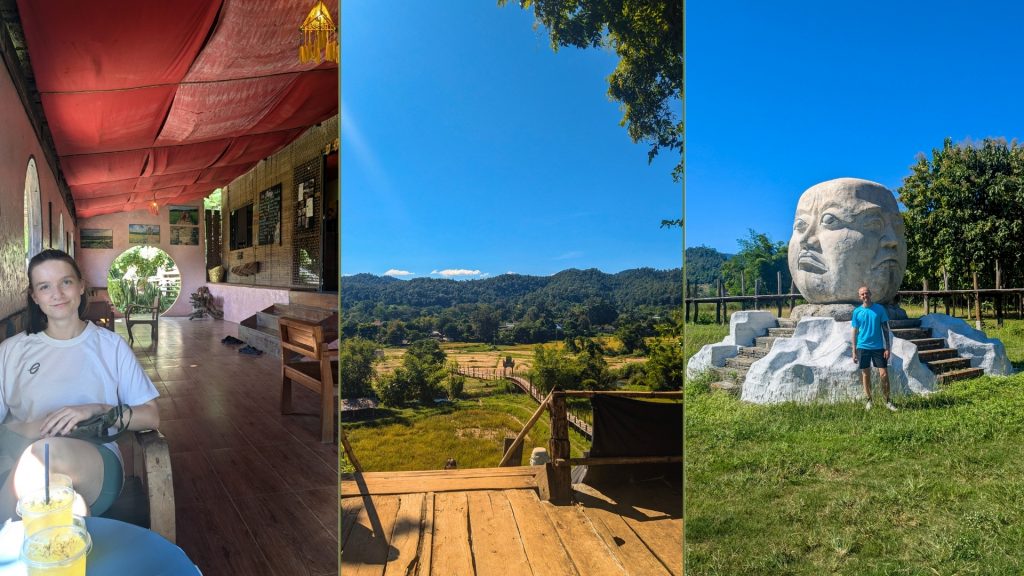
We enjoyed the atmosphere so much that we ended up spending an hour exploring the bridge and the temple. It’s probably best to go early to avoid the midday heat and to experience the serenity before any tour groups arrive (though it’s rarely crowded). We also highly recommend getting a coffee or tea at NamNeng Tea Shop. This little cafe is located along the bridge, not in front of the bridge, where there is another cafe. We ended up stopping at both, but really loved that the owner of NamNeng took her time to explain to us how each tea was made. If you come around October, the rice paddies will be at their lushest and brightest. We visited in late November, and it wasn’t that green anymore.
Read more about Thailand’s longest bamboo bridge here.
Mae Hong Son Food Market
Located just a few minutes’ walk from the lake, the Mae Hong Son Food Market (sometimes called the morning market) is where locals shop for fresh ingredients, snacks, and breakfast dishes. It’s busiest early in the morning – think 6:00 to 8:30 AM – when the air is cool and full of the smells of steaming rice, grilled meats, and simmering broths.
You’ll find stall after stall of fresh vegetables, exotic fruits, pickled things in jars, herbs, and local delicacies like tua nao (fermented soy discs), sticky rice wrapped in banana leaves, and Shan sweets you won’t see anywhere else in Thailand. It’s an ideal place to grab a bowl of rice porridge or Shan noodles and sip on strong Thai coffee while watching the town wake up. We love visiting morning markets like this when travelling – they give you a real feel for the rhythms of daily life. And best of all, it’s cheap, delicious, and refreshingly untouristy.
Wat Phra Non
Tucked away near the base of Doi Kong Mu hill, Wat Phra Non is a lesser-known temple with a peaceful atmosphere and a surprising gem inside – a large reclining Buddha statue, one of the oldest in Mae Hong Son. The temple’s name literally means “Temple of the Reclining Buddha,” and it’s said to date back to the early 1870s. The Buddha figure itself is serene and expressive, with a quiet smile and fine detailing.
The surrounding grounds are simple but serene, with flowering trees, monks’ quarters, and shaded benches perfect for a short rest. While it’s not as visually grand as some other temples, Wat Phra Non has a deeply calming presence. We stopped by mid-morning and found ourselves lingering longer than expected, listening to birdsong and watching a group of novice monks sweeping leaves in the courtyard. If you’re interested in Buddhist culture but want to avoid crowds, this is the spot.
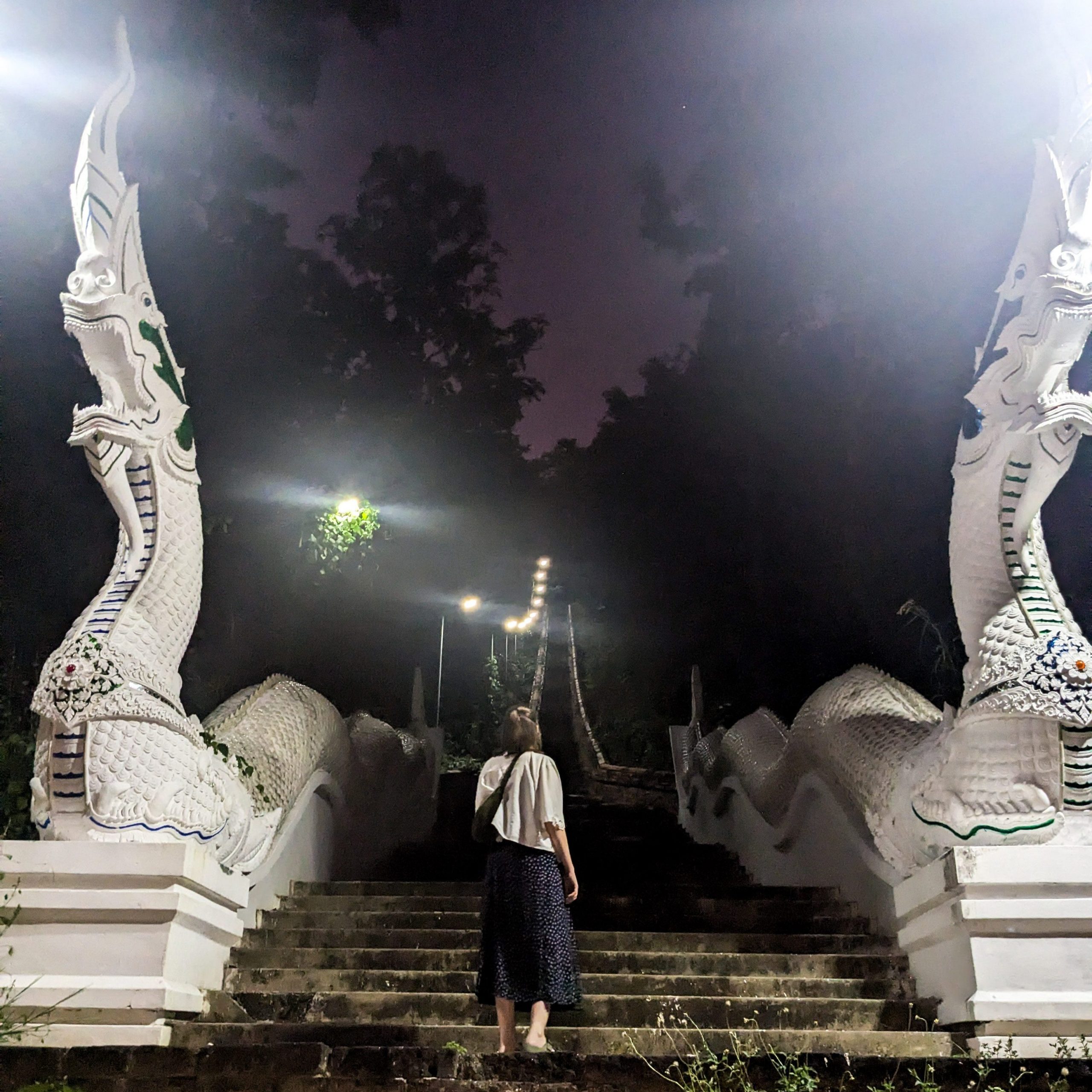
Pai
Pai is probably the second most popular destination in northern Thailand, right after Chiang Mai. Set in a wide valley surrounded by forested mountains, it’s a quirky, creative town known for its artsy cafés, yoga retreats, and hot springs.
When I visited Pai a few years ago, however, I was a bit disappointed with how overcrowded the place was, with predominantly Western tourists. Now, obviously, I was one of them, but I couldn’t help but feel guilty towards the locals. During my three-day stay, I barely interacted with any locals outside of the people running guesthouses, restaurants, or tour services. It almost felt like a stage set – beautiful, but curated for tourism. It felt as though this town existed more for tourists than for locals. This is a major reason why I personally don’t want to visit Pai again. But that doesn’t mean it’s not an amazing place. And if you’re looking for yoga retreats and vegetarian/vegan food or just an escape into nature, this place is definitely worth visiting. But it feels significantly less local and authentic than Mae Hong Son City.
Pai Canyon
Pai Canyon is one of the most well-known attractions in the area, and it’s easy to see why. Just a short drive from town, this natural formation offers sweeping views of the valley, especially at sunset when the sky turns golden and the ridgelines start to glow. The landscape is pretty unique – narrow, dusty paths wind through reddish sandstone ridges with steep drops on either side. It’s not a huge site, but it’s fun to walk around, and it definitely makes for good photos. Just be aware that it can get very busy at sunset and there’s not much shade, so bring water and a hat. We went as part of a private tour and enjoyed it as a relaxed stop to watch the sun go down after a hot day of sightseeing.
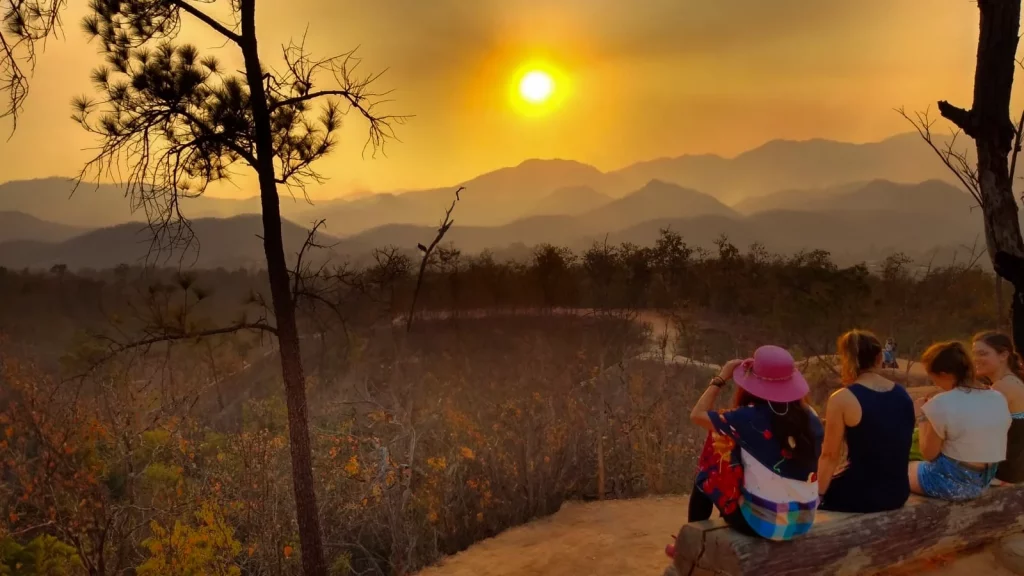
Muang Rae Hot Springs
If you’re in the mood to soak in warm mineral waters while surrounded by nature, the Muang Rae Hot Springs are a lovely option. Less crowded than the more famous Pai Hot Springs, Muang Rae feels a bit more local and low-key. The pools are simple – don’t expect a spa setup – but the water is warm, clear, and incredibly relaxing, especially on a cool morning. If you’ve been on the road for a few days, this is a good place to unwind for an hour or two.
Walking Street
Every evening, Pai’s main street transforms into a buzzing night market full of colour, smells, and music. Street food vendors set up stalls selling everything from pad Thai and mango sticky rice to more experimental fusion dishes, and the vibe is very relaxed and backpacker-friendly. There are also stalls selling clothes, jewellery, handmade soaps, and artwork – a lot of it made by creative expats or local artists. It’s definitely touristy, but still fun, especially if you enjoy browsing and snacking your way through dinner. Even if you’re not into shopping, it’s a great place to people-watch and soak in Pai’s artsy atmosphere.
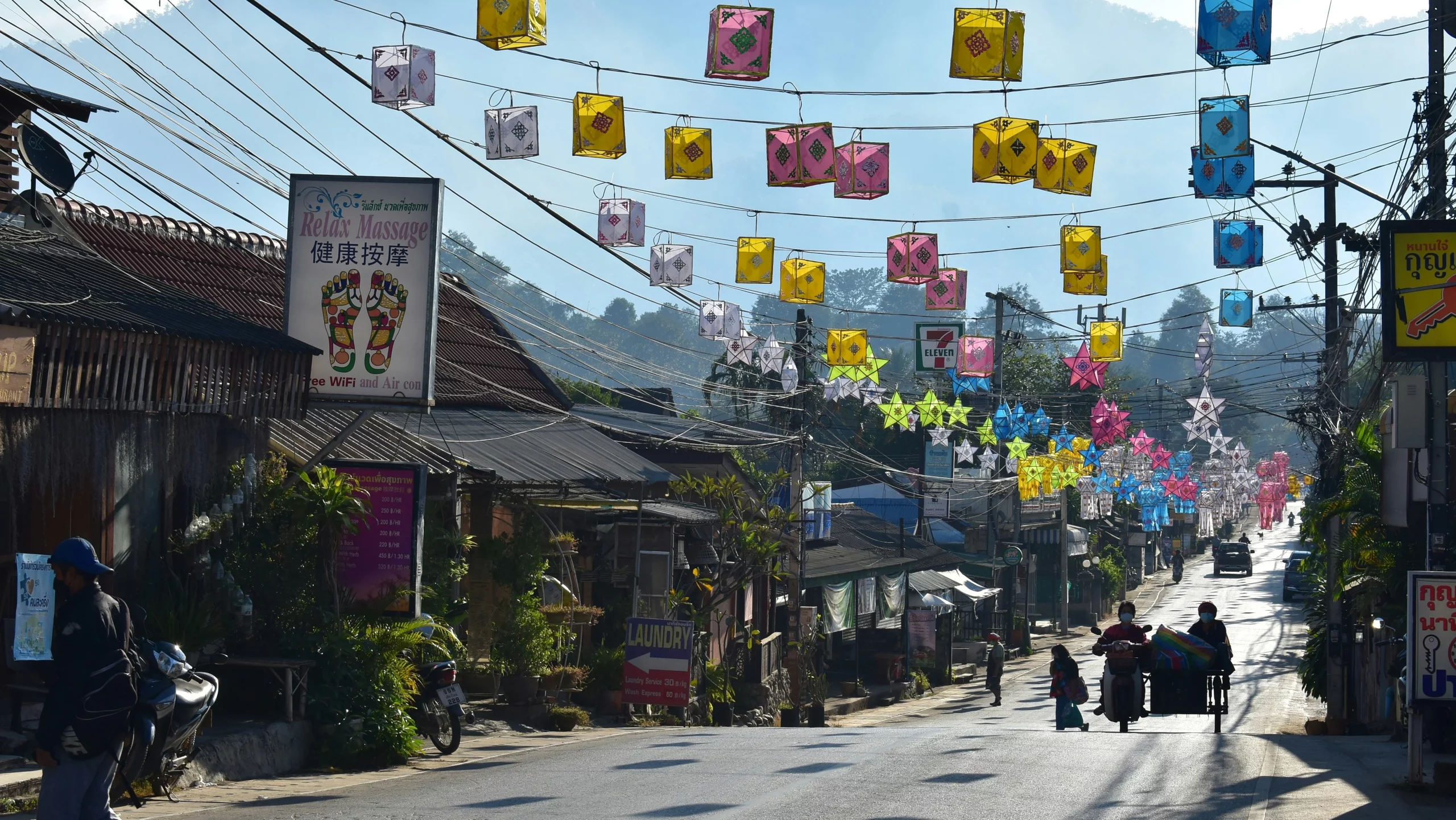
Kho Ku So Bamboo Bridge
Kho Ku So (or Kho Kuu So) Bamboo Bridge was one of the highlights of our day tour around Pai. This long wooden bridge stretches across a wide, open rice field, leading to a small temple at the far end. It’s peaceful, photogenic, and really calming to walk along – the kind of place where you find yourself slowing down without even realising it.
That said, we visited in late February, and the timing wasn’t ideal. The fields were dry and brown from the heat, and the area felt a bit dusty rather than lush. If you want to see the bridge at its best, we’d recommend coming around October or November, when the rice is green and the whole landscape looks more alive. Still, even in the dry season, it was a pleasant stop and a good place to take in some fresh air away from town.
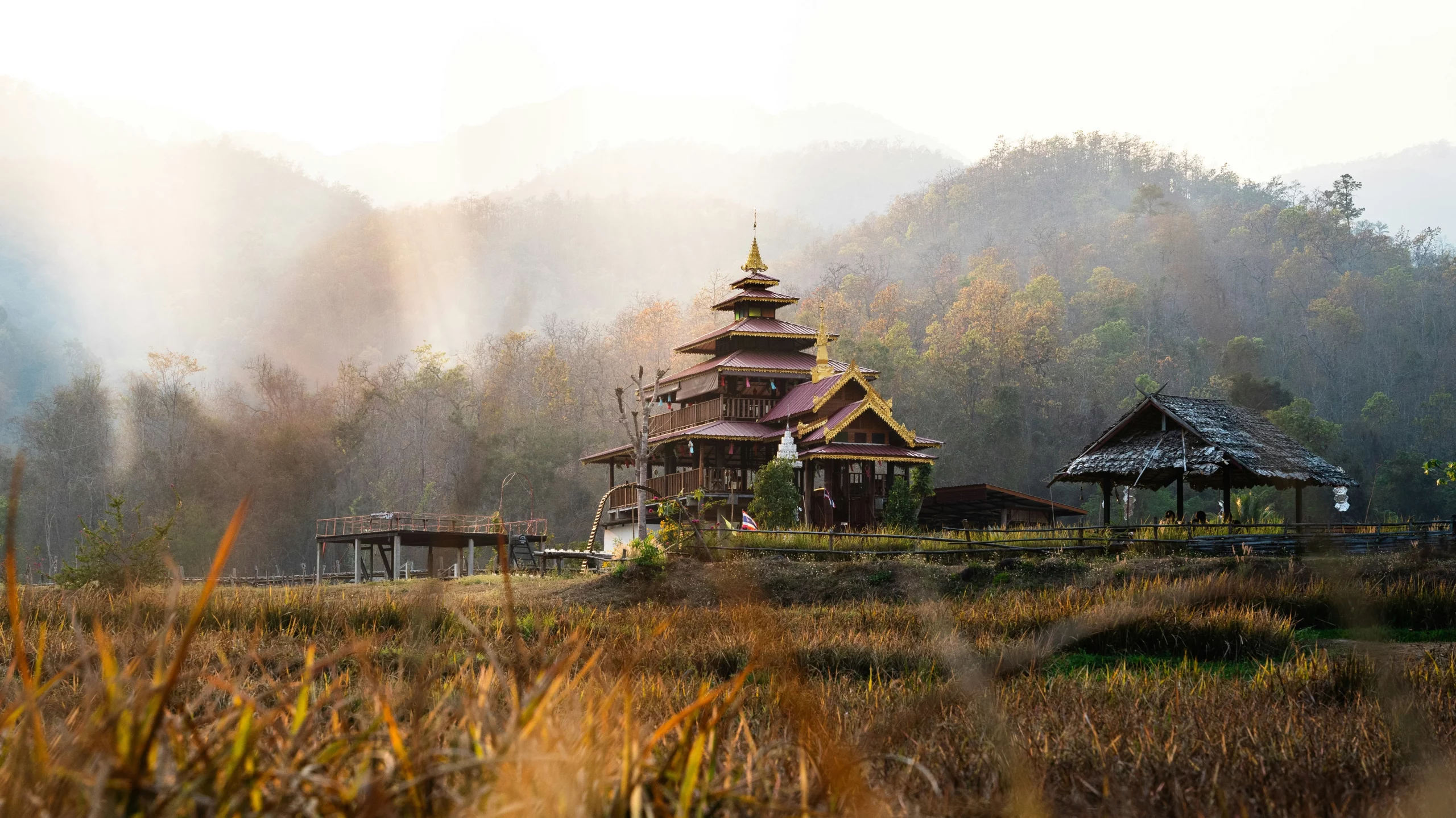
Pam Bok Waterfall
Pam Bok Waterfall was also included in our private tour, but to be honest, it didn’t really impress us, and we wouldn’t necessarily recommend it unless you’re visiting in the right season. We went at the end of February, which is dry season in northern Thailand, and the waterfall was little more than a trickle. The hike to get there is short and easy, but without water flowing, the spot didn’t feel all that special. It was dusty, hot, and pretty underwhelming. We imagine it’s more enjoyable in the rainy season or just afterwards, when the water is actually flowing and the area is green. If you’re short on time or travelling in the dry months, this might be one to skip.
Ban Rak Thai
Hidden in the far north near the border with Myanmar is Ban Rak Thai, ‘The Thai Loving Village’. It is one of the most picturesque and unique villages in the province. Former Kuomintang soldiers who fled China after the civil war founded this village. To this day, the village retains its Yunnanese heritage, from the architecture to the language and especially the food.
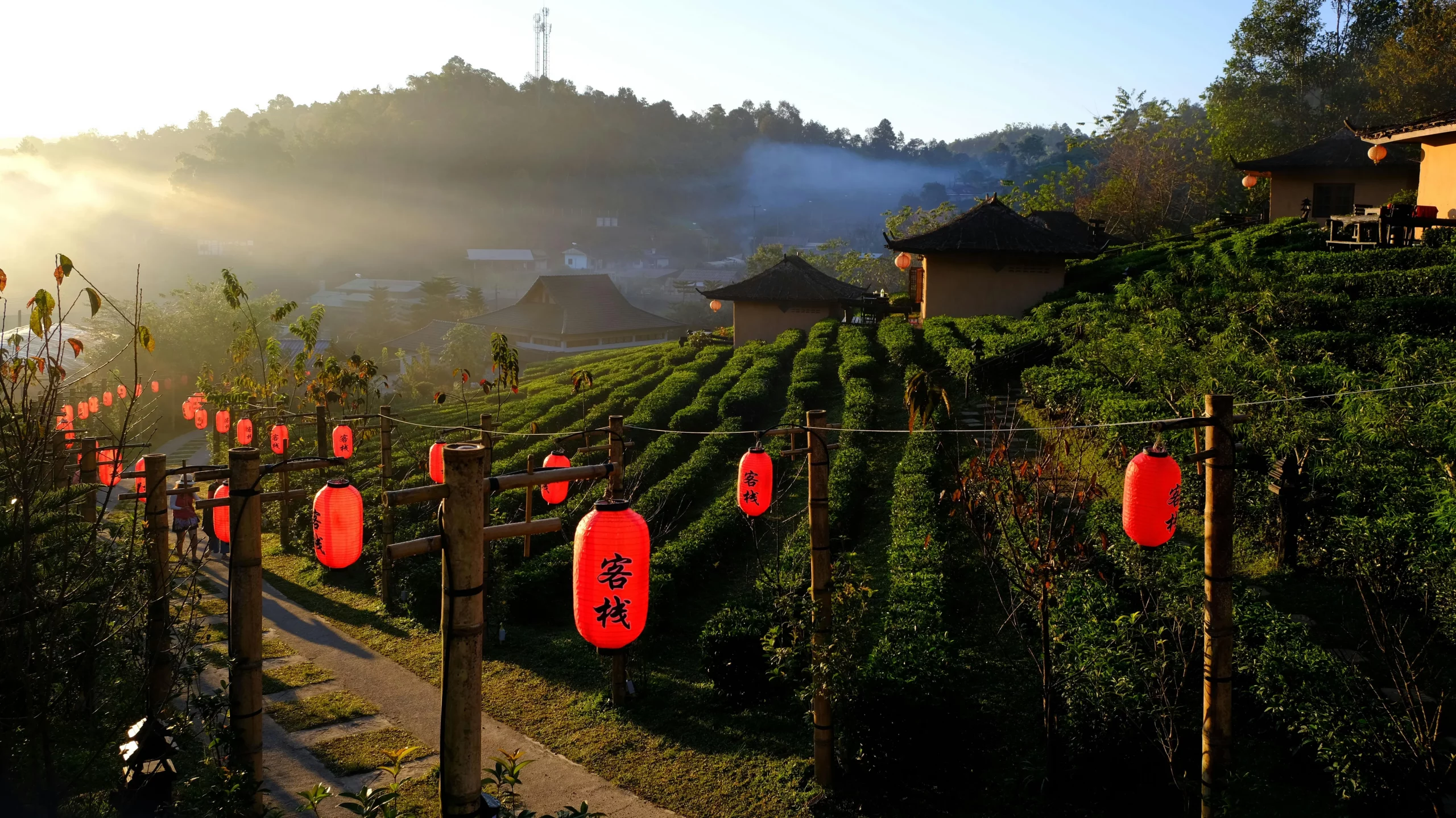
What really makes Baan Rak Thai special, though, is its setting. The village wraps around a peaceful lake, surrounded by tea plantations and misty hills. You can sip freshly brewed oolong tea with views of the water, sample homemade Yunnan pork buns, or stay overnight in a tea-themed guesthouse. It’s a bit of a detour from the main Mae Hong Son Loop, but absolutely worth the effort if you have the time. You definitely need your own car or scooter to get there, as there is no bus stop near Ban Rak Thai.
The Mae Hong Son Loop
The Mae Hong Son Loop is one of those trips that feels like a real adventure. It’s a journey through some of the most beautiful and untouched parts of northern Thailand. The full loop is about 600 kilometres long, starting and ending in Chiang Mai, and it takes you through mountain towns like Pai, Mae Hong Son City, Mae Sariang, and plenty of smaller villages in between. Along the way, you’ll pass forested hills, misty valleys, rice paddies, waterfalls, and tiny roadside stalls selling tea, noodles, or grilled bananas.
What makes the loop so special is that the drive itself is an amazing experience. There are close to 1,900 curves, and yes, it’s as twisty as it sounds, but that’s also what makes it so scenic. Some people ride the loop on motorbikes, which can be fun if you’re experienced.
Give yourself at least five or six days, more if you want to take it slow. Some places, like Pai, are popular and easy to get stuck in, but others, like Mae Sariang or tiny villages you haven’t heard of, might surprise you with their peaceful charm. One of the best parts of the loop is just pulling over on a whim – to take a photo, grab a snack, or explore a quiet temple that isn’t in any guidebook. That sense of freedom is what makes the Mae Hong Son Loop so unforgettable.
What to Eat in Mae Hong Son
Mae Hong Son’s cuisine reflects its proximity to Myanmar and its diverse ethnic makeup, resulting in flavours you won’t find elsewhere in Thailand. Many dishes use fermented soy, mountain herbs, and heartier cooking styles suited to the cooler climate.
- Shan Noodles (Khao Soi Tai Yai): This is the most iconic dish of the region. Made with rice noodles, a savoury tomato-based meat sauce (often pork), and pickled vegetables, it’s simple but incredibly comforting.
- Khao Soi: Different from the Chiang Mai version, the Mae Hong Son style is often spicier and has a stronger turmeric kick.
- Nam Prik Ong: A rich chilli-tomato-pork dip served with fresh and steamed vegetables.
- Yunnan Tea Pork: This slow-cooked pork is infused with tea leaves and served with rice or buns. It is a speciality in Ban Rak Thai.
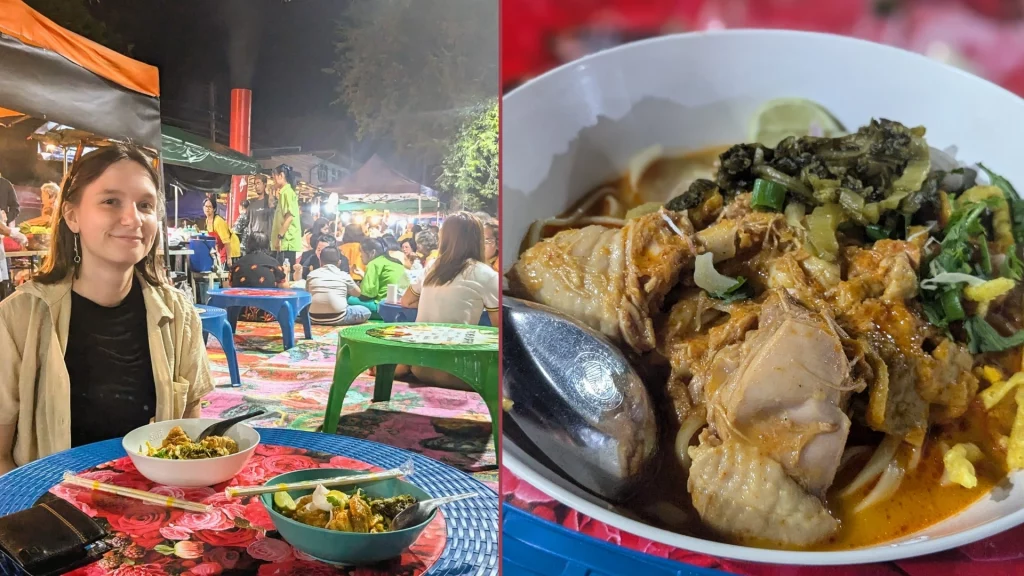
If you’re a fan of street food, the night markets in Pai and Mae Hong Son City are excellent places to try a bit of everything. Don’t miss out on local teas and seasonal fruits from the mountain orchards.
FAQ: Mae Hong Son
Q: What is Mae Hong Son known for?
A: Mae Hong Son is best known for its mountainous scenery, cool climate, remote villages, and cultural diversity. It’s also famous for the scenic Mae Hong Son Loop – one of Thailand’s most rewarding road trips.
Q: Where is Mae Hong Son?
A: Mae Hong Son is a province bordering Myanmar in the far northwest of Thailand. It’s about 250 km west of Chiang Mai, surrounded by mountains and national parks.
Q: How do I get to Mae Hong Son?
A: You can reach Mae Hong Son by direct flight from Lampang or Bangkok. Another option is to take a van or drive yourself along the Mae Hong Son Loop.
Q: How long is the Mae Hong Son Loop?
A: The full loop covers about 600 kilometres and typically takes 4 to 7 days to complete. This obviously depends on how many stops you make.
Thanks for reading this post! Have you ever been to Mae Hong Son? Let us know in the comments!